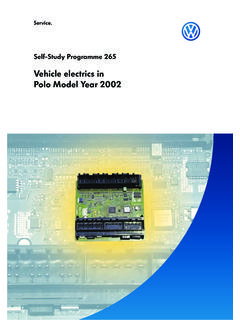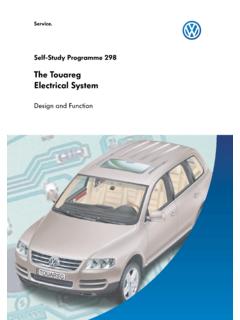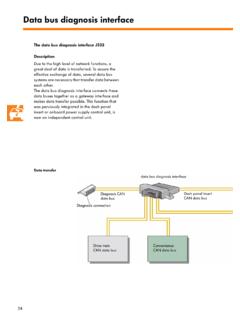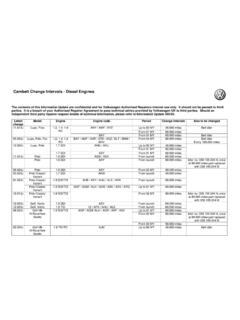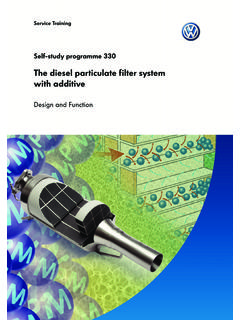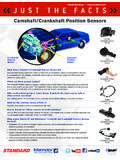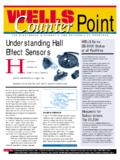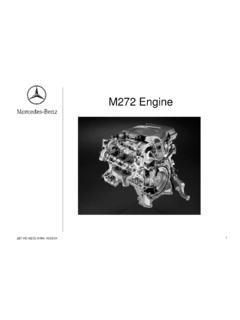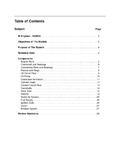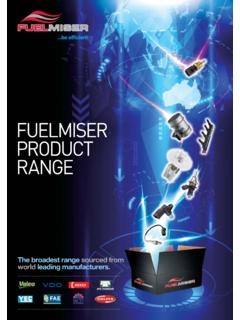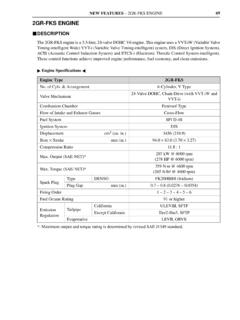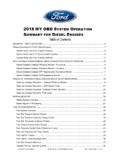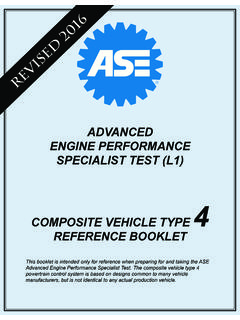Transcription of Design and Function - VolksPage
1 1 Service TrainingSelf-study Programme TSI Engine with Dual-chargingDesign and Function2 The self-study programme shows the Design and Function of new contents will not be current testing, adjustment and repair instructions,refer to the relevant service TSI* engine is the world s first petrol engine with direct petrol injection and dual-charging. Volkswagen is thus laying another milestone in engine development.* The term TSI is a protected abbreviation of the following pages, we will introduce you to the Design and Function of the new TSI engine with dual-charging. S359_0023 Introduction .. 4 Engine mechanics .. 6 Poly-V-belt drive .. 6 Timing chain .. 7 Cylinder block .. 8 Cylinder head and valve train .. 10 Dual-charging with supercharger and turbocharger .. 11 Crankcase breather and ventilation .. 21 Oil system .. 22 Dual-circuit cooling system.
2 24 Demand-regulated fuel system .. 26 Exhaust system .. 27 Engine Management .. 28 System Overview .. 28 CAN networking .. 30 Engine Control Unit .. 31 Sensors .. 32 Actuators .. 46 Functional Diagram .. 58 Service .. 60 Test Yourself .. 62 Contents4 IntroductionThe special concept behind this engine is, above all, the combination of direct petrol injection, dual-charging and Volkswagen used direct petrol injection for the first time in the Lupo FSI model year In dual-charging, the engine is charged by a mechanical compressor and/or a Downsizing is replacing a large-capacity engine with a powerplant with smaller displacement and/or fewer cylinders. This reduces the internal friction and this the fuel consumption without the power or torque being Technical FeaturesTechnical features Two output versions delivering 103kW and 125kW Bosch Motronic MED Homogenous mode (Lambda 1) Double injection catalytic converter heating Turbocharger with waste gate Additional mechanical supercharger Intercooler Maintenance-free timing chain Engine cover with vacuum tank for the intake manifold flap control Plastic intake manifold Continuous inlet camshaft timing adjustment Grey cast iron cylinder block Steel crankshaft Duo-centric oil pump Dual-circuit cooling system Fuel system regulated according to requirements High-pressure fuel pump with a delivery pressure of up to 150 barS359_003 Thanks to this concept, it has greater performance than engines with the same output and also consumes less fuel.
3 It therefore meets customer demands for economic FSI engines with a high level of TSI enginerpmNmkWS359_093 Torque [Nm]Power [kW]rpmNmkWS359_094 Power [kW]To r q u e [ N m ]Torque and power diagramThe different output and torque levels are achieved using software. The engine mechanics are the same in both TSI engineTe c h n i c al d a t aEngine codeBMYBLGType4-cylinder in-line engine4-cylinder in-line per cylinder44 Compression ratio10:110:1 Maximum output103 kW at 6,000 rpm125 kW at 6,000 rpmMaximum torque220 Nm at 1,500 4,000 rpm240 Nm at 1,750 4,500 rpmEngine managementBosch Motronic MED Motronic MED unleaded RON 95 Super Plus at RON 98(Super unleaded at RON 95 with slightly higher consumption and torque reduction in the low rev ranges)Exhaust gas treatmentMain catalytic converter,Lambda controlMain catalytic converter,Lambda controlEmissions standardEU 4EU 46 Engine mechanicsAlternatorbelt pulleyBelt tensionerAir-conditioning compressorbelt pulleyAncillary componentsdrive beltCompressor belt pulleyCamshaft belt pulleyCoolant pump pulley Pulley for supercharger magnetic clutch N421 Tensioning pulleySuperchargerdrive beltTensioningpulleyPoly-V-belt driveS359_004 The TSI engine has two The ancillary component drive belt is a six-groove poly-V-belt.
4 It drives the coolant pump, the alternator and the air-conditioning compressor from the camshaft The supercharger drive belt is a five-groove poly-V-belt. It drives the compressor via the magnetic clutch pulley when the magnetic clutch is tensioning pulley ensures that the ancillary component and supercharger belts are correctly tensioned. The tensioning pulley after the crankshaft pulley also ensures that the poly-V-belt runs correctly around the crankshaft pulley and coolant pump tensionerTensioning railSprocket forcamshaft driveSprocket for drivingcamshafts and oil pumpOil pump drivetoothed chainOil pump sprocketSlide railSpring-loadedchain tensionerSprocket forinlet camshaft with vaneadjusterOutlet camshaftsprocketS359_005 Chain driveBoth the camshafts and also the oil pump are driven by the crankshaft via a maintenance-free timing timing adjustmentA load- and engine speed-dependent vane adjuster is used for the continuous inlet camshaft adjustment.
5 The adjustment range is a maximum 40 crank camshaft adjustment allows:- Very good internal exhaust gas recirculation and-improved torque pump driveThe oil pump is driven by a toothed chain with 8 mm pitch for improved is tensioned by a spring-loaded chain driveThe toothed chain drive has been optimised due to the greater loading. The toothed chain has hardened pins and heavy-duty link plates that have been adapted to the chain toothed chain is tensioned by a hydraulic chain liningOuter wallEngine MechanicsCylinder blockAs with the and FSI engines, the cylinder block has a so-called open-deck Design . This means that there are no webs between the outer wall and the cylinder has two advantages: - No air bubbles can form in this area which would lead to ventilation and cooling problems particularly with the dual-circuit cooling system,- When the cylinder head is bolted to the cylinder block, the cylinder liner deformation caused by the decoupling of the cylinder liner and cylinder block is less and more even than with a closed-deck Design with webs.
6 This results in lower oil consumption as the piston rings compensate this deformation cylinder block on the TSI engine is made from grey cast iron with lamellar graphite. This guarantees sufficient operating safety at the high combustion pressures of the TSI engine. Due to the high strength of a cylinder block made from grey cast iron with lamellar graphite compared with one made from diecast aluminium,the camshaft may be will find further information on the and FSI engines in self-study programmes 296 The and FSI engine with timing chain and 334 The fuel system in FSI engines .9 Crankshaft driveCamshaftPiston pinConnecting rodPistonCoated pistonskirtS359_007 The crankshaft drive consists of the crankshaft, the connecting, the bearing shell, the piston and the piston pin. Several modifications have been made to the crankshaft drive as the forces occurring on the TSI engine are considerably higher than with the previous FSI pistons are made from diecast combustion chamber recess with a deflector has been worked into the piston base.
7 This leads to a strong swirling of the intake air and thus to a very good mixture outlet side of the piston is cooled with a piston cooling system. The jets open at friction of the piston package has been reduced by a graphite coating on the piston skirt and a greater skirt-to-wall clearance of 55 piston pin diameter has been increased from 17 to 19 mm due to the high ignition forged crankshaft is made from steel and is stiffer than the cast crankshaft on the FSI all, this reduces the noises from the rodThe connecting rods are fracture-split. Therefore only the same two components fit together, they are cheap to produce and good positive engagement is MechanicsS359_097 High-pressure fuel pumpRoller tappetPump camCamshaft caseInlet camshaftThe cylinder head is the same as on the FSI engine except for a few changes have been made to the valve train due to the greater loads and exhaust gas temperatures.
8 Due to the higher loads, the outlet valves are reinforced on the valve seats and the valve springs are heat-treated. Due to the higher exhaust gas temperatures, the outlet valves are filled with sodium for better heat transfer. This reduces the temperature at the outlet valves by approx. 100 caseThe camshafts, which are mounted on three bearings, are inserted into the camshaft case. Their axial play is limited by the cover and the camshaft case. The high-pressure fuel pump is bolted to the camshaft case. It is driven by a double cam on the inlet camshaft. Due to the higher injection pressures and the fuel quantities to be delivered compared with previous FSI engines, the pump stroke has been increased from 5 to mm. The friction is reduced by a roller tappet between the high-pressure fuel pump and camshaft and halves the drive moment of the high-pressure fuel seal between the camshaft case and cylinder head is formed with a liquid gasket.
9 Please note the repair instructions in valveOutlet valveCylinder headCylinder head and valve train11 Dual-charging with supercharger and turbochargerMechanicalsuperchargerS359_0 09S359_092 TurbochargerSuperchargerThe supercharger is a mechanical charger that is activated by a magnetic :- Faster build up of boost pressure- High torque at low revs-Only activated when required- No external lubrication and cooling necessaryDisadvantages:- Requires drive power from engine- Boost pressure is produced at any engine speed and is then regulated with part of the generated power being lost againTurbochargerThe turbocharger is constantly powered by the exhaust :- Very good efficiency due to use of exhaust gas energyDisadvantages:- In a small engine, the boost pressure produced in the low rev ranges is not sufficient to generate high torque- High thermal loadingCurrent charged engines mostly use turbochargers.
10 The TSI engine is the first to use a combination of supercharger and turbocharger. That means the engine is charged by a supercharger in addition to the turbocharger depending on the torque MechanicsS359_010 MechanicalsuperchargerSuperchargerdrive beltCatalytic converterIntercoolerExhaust manifoldMagnetic clutchAncillarycomponents drivebeltRegulating flap control unit J808 Exhaust gasThrottle valve module J338 Fresh airIntake manifoldIntake manifoldpressure sender(supercharger) G583with intake airtemperature senderG520 Air filterCharge air pressure sender G31 with intake air temperature sender G299 Intake manifold pressure sender G71 with intake air temperature sender G42 Charge pressure control solenoid valve N75 Pressure canisterTurbochargerWaste gate flapSchematic diagram of all supercharging componentsThe schematic diagram shows the basic set-up of the dual-supercharging system and the path of the fresh intake is drawn in through the air position of the regulating flap is defined in the regulating flap control unit determining whether the air flows via the supercharger and/or straight to the air flows from the turbocharger via the intercooler and the throttle valve module into the intake air recirculation valve N24913 The diagram shows the working ranges of the mechanical supercharger and the turbocharger.
